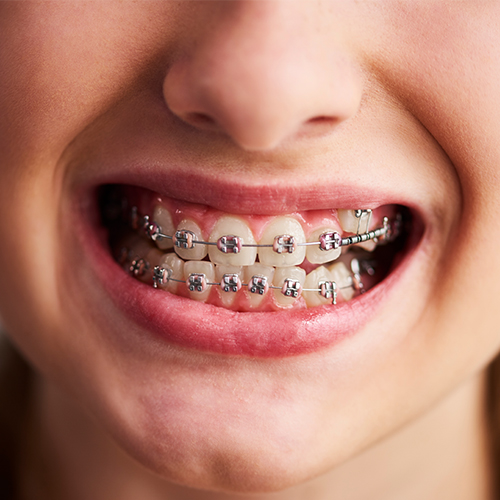Orthodontics
Orthodontic Treatment in KPHB | Jubilee Hills, Hyderabad
What is Orthodontics and why is it important?
At Dr. Praveen’s, we take pride in offering the best orthodontic treatment in Hyderabad, with dental appliances such as braces, aligners, and retainers.
Orthodontics for Children
As every patient is different, orthodontic specialists are trained to determine the best time to begin orthodontic treatment. Because readiness to begin orthodontic treatment is determined more by dental development than chronological age, it is best to consult with an orthodontic specialist no later than age 7 to determine the best time to begin orthodontic treatment.
- When Should Children First See the Orthodontist?
- Children’s Brace Styles
The American Association of Orthodontists recommends that children be evaluated by an orthodontic specialist by the age of seven. Your child’s first set of molars has erupted, providing the orthodontist with information about how their teeth are developing.
Although very few patients require orthodontic intervention at this age, your orthodontist can still diagnose conditions and make recommendations to simplify future treatment.
Children’s mini-silver braces are the most popular option for children. The rubber bands that secure the wire to the bracket are available in 24 different colours and can be replaced at each adjustment visit.
Patients enjoy designing their own colour schemes for their braces, which makes their orthodontic experience more enjoyable and personal.
Orthodontics for Adults
Recent advancements in orthodontic technology have introduced products such as clear ceramic brackets and Invisalign® to aesthetically satisfy the adult orthodontic patient.
- Clear Braces
- Lingual Braces
- Invisalign®
Clear braces are the most popular option among adult orthodontic patients. Their function is identical to that of the traditional mini-silver bracket, but since they are made of ceramic material, they are almost invisible on the teeth.
Recent advancements in the materials used to fabricate ceramic braces have made these brackets stain-resistant and very comfortable for adult orthodontic patients.
Adults who want the least noticeable braces possible can opt for lingual braces. Lingual braces are worn on the insides (the back) of the teeth rather than the front.
They cannot be worn by every patient needing braces, because some teeth are too small or irregularly shaped to fit the metal on the back of the teeth.
They are, however, ideal for athletes, celebrities, models, and anyone who does not want others to know about their teeth but wants to improve their teeth and smile.
Invisalign® is a popular option amongst adult patients. With the Invisalign® system, patients are required to wear a series of clear aligners over a period of time to achieve correction.
Not all patients are candidates for Invisalign®, so it is extremely important to be evaluated by an orthodontic specialist to determine whether or not Invisalign® is the best option for you.
Surgical Orthodontics
This is where surgical orthodontics shines, as it can correct a wide range of issues that traditional orthodontic treatments, such as braces, cannot.
- What is Surgical Orthodontics?
- Who is in Need of Surgical Orthodontics?
- How Surgical Orthodontics Works?
Surgical orthodontics’ primary function is to straighten the jaw. While braces are frequently used to straighten teeth, additional surgery may be required in conjunction with braces to straighten the jaw. This is also done to aid in tooth straightening because the teeth can be moved to their proper position after the jaw surgery is finished.
Surgical orthodontics begins with x-rays of the patient to determine the type of problem they are experiencing. The teeth in the jawbone are then properly aligned, which can take up to a year. Following that, the jaw is straightened surgically using orthodontics.
Surgical orthodontic procedures include surgical-assisted rapid palatal expansion, corticotomy, orthognathic surgery, and orthodontic implants and bone plates.
Surgical orthodontics is not performed on children or adolescents who are still growing because their jaws may continue to grow. It is ideal for non-growing patients, which are typically girls aged 16 and up and boys aged 18 and up.
The jaw must have completed its growth before surgery. However, pre-surgery tooth movement with braces can begin 1-2 years before surgical orthodontics is performed.
Surgical orthodontics is performed on patients who have never had braces and notice that their jaw is crooked, affecting their appearance, bite, and smile, or on patients who have had braces but are experiencing problems with their jaw. It is performed in a hospital setting by an oral surgeon.
The surgery itself may take several hours to complete, depending on the procedure performed. If the patient is having lower jaw surgery, their jawbone will be separated behind their teeth in order to move the jaw backwards or forwards.
Upper jaw surgery involves moving the jaw backwards or forwards, lowering or raising it, or any combination of these movements. For better support and movement, bone in the jaw may need to be removed or added. The recovery period lasts approximately 4–8 weeks, though you can usually return to work or school after two weeks.
If you’re unhappy with your jaw, whether it’s because you can’t breathe and it’s uncomfortable, or you just don’t like the way it looks, talk to your orthodontist about surgical orthodontics. It not only improves your self-esteem but also improves your chewing and function.
Braces Care
- About Traditional Braces
- How They Work
- Benefits of Traditional Braces
Brackets and wires are the components of traditional stainless steel braces. The brackets are square in shape and made of metal or stainless steel. These are worn over the teeth that need to be straightened.
There are also wires or ties in between each bracket that act as an anchor to gently pull the teeth into their proper location. Patients wearing braces must return to their orthodontist on a regular basis to have the wires tightened and the teeth moved further.
Traditional braces’ brackets are bonded to the teeth, where they will remain until treatment is completed. Braces are typically worn for 2-3 years by most patients, but they can be worn for as little as one year or as long as four years. Braces always apply pressure to the teeth, causing them to shift into a new position.
Some patients, particularly those with more severe bite or jaw issues, may need to wear headgear at night.
Orthodontic treatments include traditional metal braces, clear ceramic braces, lingual braces, and Invisalign®. Because of their effectiveness and low cost, traditional stainless steel braces are the most commonly used type of brace.
They are also effective with all levels of orthodontic issues, including severe overbites and overcrowding. Other types of braces will not be as effective in dealing with these more advanced issues.
Retention Protocol
After your braces are removed, you will remain an active patient in our office for an additional 18–24 months so that we can evaluate your teeth and ensure that your retainers are being worn and fit properly.
- Wearing the Retainer
In order to avoid relapse, it is critical to wear the retainers as prescribed by Dr. Praveen (or shift of the teeth). It takes about a year for the bone to heal after tooth movement. Retainers are typically worn full-time for a few months, then at night for the rest of your life if you want your teeth to stay in the corrected position. Lisping and excessive salivation are normal when you first put on your retainers, but you will quickly adjust to your new retainers.
If you break or lose your retainer, please contact us right away to schedule an appointment. Broken retainers can sometimes be repaired, so bring them to your appointment. If it cannot be repaired or is lost, a new retainer will be manufactured at an additional cost.
FAQ’s
- Who is an Orthodontist?
- Orthodontics for Children
- What is Invisalign?
- What are the Primary Benefits of Invisalign?
- Types of Appliances
An orthodontist is a dental professional who has completed 2-3 years of specialised training after graduating from dental school and is a specialist in teeth straightening. The orthodontic specialist is concerned with the diagnosis and management of malocclusions (Latin for “bad bite”).
Although orthodontic treatment can benefit patients of all ages, it is most effective during the adolescent growth spurt, which occurs between the ages of 8 and 14 years old. The timing of your child’s orthodontic treatment is critical to ensuring a stable and healthy treatment outcome.
Because every patient is different, orthodontic specialists are trained to determine the best time to begin orthodontic treatment. Because readiness to begin orthodontic treatment is determined more by dental development than chronological age, it is best to consult with an orthodontic specialist no later than age 7 to determine the best time to begin orthodontic treatment.
Invisalign® is by far the most popular option for adult orthodontic patients. Invisalign® uses cutting-edge technology to create plastic aligners that are worn over the top and bottom teeth. Because Invisalign® is a self-managed programme, treatment outcomes are largely dependent on patient compliance.
During your initial consultation, Dr. Praveen will discuss whether Invisalign® is the best treatment option for you.
Invisalign is clear. You can have your teeth straightened without anyone knowing.
Invisalign is a removable aligner. In contrast to braces, you can eat and drink whatever you want during treatment. To maintain good oral hygiene, you can also brush and floss normally.
Invisalign is a pleasant experience. There are no metal brackets or wires to cause mouth irritation, as there are with braces, and because there are no metal or wires, you spend less time in the doctor’s chair getting adjustments.
Before you begin treatment with Invisalign, you can view your own virtual treatment plan to see how your straight teeth will look when it is finished.
There are various types of removable dental appliances that support the treatment of crooked teeth or misaligned jaws. A few of the more common appliances are listed below:
- Expanders
- Herbst Appliance
- Mouth Guards
- Habit Breaking Appliance
- TMJ splints




